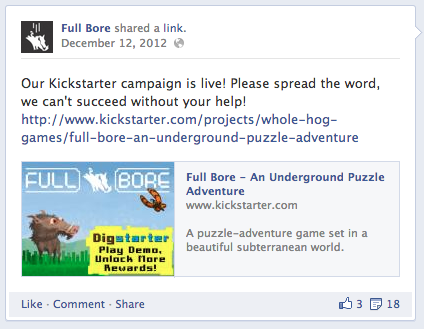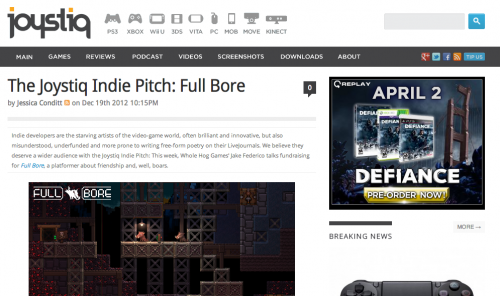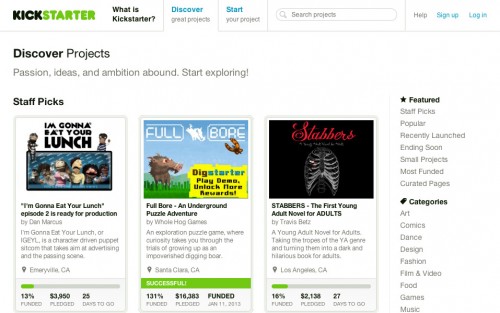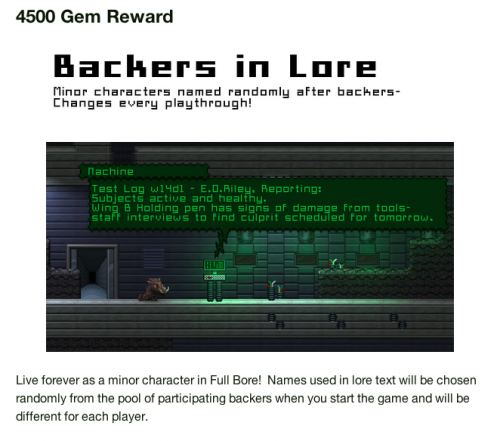Successful Kickstarter Dos and Don’ts [CASE STUDY]
Achieving a successful Kickstarter is hard. Just ask Finn Beazlie, Casey Carlin or Jake Federico of indie studio Whole Hog Games. In 30 days, Whole Hog Games exceed it’s Kickstarter funding goal of $12,500 to support its first title, Full Bore. However, for this team, Kickstarter became more than a means of funding. It taught the three how crucial marketing is for not only a successful Kickstarter, but any indie success.
Successful Kickstarter Case Study:
Whole Hog Games
Challenge
Whole Hog Games needed $12,500 to fund the completion of its first title, Full Bore.
Solution
On Dec. 12, 2012, Whole Hog Games launched a Kickstarter with a goal of raising $12,500 in 30 days.
What the Team Did Right:
-
Created Engaging Page Content:
To ensure a compelling Kickstarter page, Whole Hog Games spent a great deal of time on page content. The team started by studying successfully funded Kickstarters and searched for commonalities. Whole Hog Games applied the following to create a professional and engaging page: - Get to the point and keep your page short: potential backers might only read the first sentence and look at images. You need to make an immediate impression.
- Use visual elements throughout the page: too much text and not enough eye candy will overwhelm and bore potential backers.
- Introduce your game AND team in your video: potential backers like to feel a connection with the people they are backing.
-
Started Promotion with Friends and Family:
Before the launch of its Kickstarter, Whole Hog Games attempted pre-launch marketing with little success. Other than a few fans gained from an article published in Nerdophiles and postcards passed out at PAX 2012, the team’s audience was friends and family. However, a time crunch and depleting funds forced the studio to launch its Kickstarter.
On Dec. 12, 2012, Whole Hog Games launched and began promotion with friends and family via social media channels. The team received tremendous support: friends and family spread the word and contributed heavily, especially in the first third of the campaign. At this initial promotion’s height, Whole Hog Games reached 8,000 people on Facebook.
-
Secured Articles in Gaming Press:
As Whole Hog Games promoted its Kickstarter to friends and family, it reached out to the gaming press. It took a couple of weeks and email exchanges, but the team secured articles in Joystiq and Kotaku. On the days these articles ran, Whole Hog Games gained two dozen backers. In addition, the team estimates 20 to 30 percent of its funding resulted from these press mentions.
-
Became a Kickstarter Staff Pick:
Partway through its Kicksarter campaign, Full Bore was selected as a Kickstarter Staff Pick. The team is uncertain as to why it was chosen, but thinks it might be related to Digstarter, its in-game contest (discussed later). Nevertheless, becoming a Staff Pick resulted in an immediate funding bump. The team estimates eight to 10 percent of its funding resulted from becoming a Staff Pick.
-
Maintained Engagement with an In-Game Contest:
Toward the end of its campaign, Whole Hog Games ran an in-game contest to keep the momentum going. Digstarter, its in-game contest, asked fans to find and collect gems as they played Full Bore. The more gems found collectively, the more the team rewarded its backers. This unique contest incentivized current backers to stay involved and prospective backers to get involved. More importantly, Digstarter helped the team avoid a fundraising slump in the last third of its campaign.
Where the Team Went Wrong
-
Launched in December:
From a PR point-of-view, December is one of the worst times to launch a Kickstarter. During this time of year, the gaming press is on holiday and runs canned, retrospective coverage. The team was lucky to get featured in Joystiq and Kotaku, but was hoping for more. If they could do it again, Finn, Casey and Jake would launch in January when the gaming press actively searches for new stories. -
Not Enough Pre-Launch Marketing
While Whole Hog Games’ friends and family did a tremendous job spreading the word and contributing, the team admittedly could have benefited from a more diverse audience. If the team could do it again, Whole Hog Games would have invested more time and energy into pre-launch marketing.
Results
In 30 days, Whole Hog Games exceeded its funding goal by 31%, raising at total of $16,383 to achieve a successful Kickstarter.
About Whole Hog Games
Whole Hog Games is a team of three developers from northern California who went to the same high school, went their separate ways and subsequently reunited to create video games. Full Bore, the team’s first title, is an exploration, puzzle game set in a beautiful, convulted underground network. Players rely on curiosity and logic to to pry apart the game world, uncovering the wonders and mistakes of the past. Learn more about Whole Hog Games and Full Bore at WholeHogGames.com or pre-order Full Bore.
Many thanks to Whole Hog Games for allowing Indie Game Girl to cover its successful Kickstarter.
Leave a Comment
Only registerd members can post a comment , Login / Register

![Successful Kickstarter Dos and Don’ts [CASE STUDY]](https://indiegamegirl.com/wp-content/uploads/2014/11/successful-kickstarter-750x400.jpg)

18 Comments
Nikol
about 12 years agoThanks to Whole Hog for sharing their insight. I am still contemplating on whether it's worth all the effort to get money from Kickstarter. Something I would like to add to this is using friends and family becomes increasingly difficult as you work on more projects. I have found that everyone is on board for the first one or two (like most of us, we don't see success until our 4th, 5th ,10th game if at all even with studying all the marketing tips and making quality) and after that you need to start reaching deeper into your network and become increasingly more active in conversation and engagement to have people help you out.
Emmy
about 12 years agoHi Nikol! Thank you for the comment. You make a great point, re: friends and family, that I totally agree with. This is why pre-launch marketing is so important to a Kickstarter. You need to diversify your audience as much as possible before you launch so you have a large pool to both spread the word and help fund the project. This is a good topic for Whole Hog Games to chime in on. Finn, Casey or Jake, do you have any additional thoughts on this?
Michael Hartman
about 12 years agoVery good post. Thanks for this information. We are about to run our very first kickstarter to fund the completion and polishing of our game, Dungeon of Elements: an RPG dungeon crawler with Dr. Mario/tetris style combat. I am trying to learn as much as possible in the meantime so we can get off to a good start. Thanks,
Emmy
about 12 years agoMichael, thank you for your comment. Learning from others' successes and failures is a great place to start in planning for a Kickstarter. Good luck!
Finn Beazlie
about 12 years agoThanks for the great comments! @Nikol: I could see where asking family and friends multiple times for help would get more difficult. We had some people we knew being extremely generous, and I wouldn't want to impose on them again after they had been so giving the first time around. We are hoping that the sales from this game allow us to become a self-sustaining studio. @Michael Hartman: Looking at successful and unsuccessful campaigns was really helpful to try to distill what it was that made a campaign appealing. One of the most important things we saw was that the more content and activity a campaign had, i.e. updates, videos, graphical page elements, the more likely they were to succeed. The length of Kickstarter page seemed to be less of a factor. I am a fan of brevity, but you don't want your page to look bare.
Finn Beazlie
about 12 years agoas far as the pre-launch marketing goes, having a trailer and lots of screenshots to show around on social media, and to try to get the attention of the press is really good. If the project is not far along enough for screenshots, concept art or other visual media that shows what your game is about is a must. We made up a presskit so that we had all the important info and images in one place so that journalists only had to click one link to get everything.
Lorraine Rorabaugh
about 12 years agoThanks for this informative article. We've just begun on Kickstarter and finding a bit challenging getting noticed. Working it one day at a time. Thanks.
Emmy
about 12 years agoFrom what I've learned from Whole Hog Games, the team had peaks and valleys in getting attention. When Finn, Casey and Jake could score and article in a gaming publication, they would hit a peak. In addition, getting listed as a Kickstarter Staff Pick boosted interested. Maybe focus your efforts on reaching out to press, or even starting some kind of in-game contest (like Whole Hog Games did) to get the staff's attention.
Tim
about 12 years agoEmmy: Fantastic article as always. Particularly interesting is the part with the in-game promotion. Genius idea. Personally I think what helped them the most was an actual demo of their game. My rate of games that I back goes higher when they have a working demo or at least some later stage gameplay footage. I'm curious what's your take on this: I'm a big fan of having a website with high quality content way before the Kickstarter campaign. However, I see many campaigns that don't even have a website up and running when their Kickstarter begins. Do you feel there is any way to make up for that lack of a marketing channel?
Emmy
about 12 years agoHi Tim! Thanks for the comment and question. You can probably tell from my posts that I am a HUGE proponent of pre-launch marketing. So yes, I agree that having a professional website with professional content where one can direct traffic to is a must. I also agree that the more time you have this site up, running and driving traffic to before the launch of your Kickstarter, the better. To answer your question, while I don't think there is any way to make up for the lack of this marketing channel, nor would I ever recommend not having it, one could use a Facebook page as a "website" and direct traffic there if necessary. But again, I wouldn't recommend it.
Finn Beazlie
about 12 years agoTim: at the time, there were very few game kickstarters that had a demo. I have been noticing that more campaigns are including a demo. Without well-known people or really broad appeal, its hard to sell people on just an idea alone.
Tim
about 12 years agoStill feels like a minority of game that do it. In any case congrats on your successful campaign!
Aurelien Folie
about 12 years agoHey! I which I had seen that post, and found that blog, before my boss launched his kickstarter campaign... Loads of things to learn from here. Would you have any advices on how to improve the marketing of a kickstarter campaign that doesn't have a defined target audience?
Emmy
about 12 years agoHi Aurelien, Thank you for the comment and glad you're getting some good info out of the blog. Not having a defined target audience makes it much harder to execute a successful marketing campaign and is not recommended. But if you're really in a jam and don't have time to define one, or aren't sure how to go about doing so, I think there are three things you can focus on:
Barrett
about 12 years agoThank you so much for this article. It reinforces a lot of the information I've heard regarding kickstarters, particularly in regard to one's personal network being the strongest foundation. Our kickstarter is still over two months away, but we intend to integrate the advice from your article into our campaign.
Emmy
about 12 years agoHi Barrett! Thanks for the comment. Glad to hear you found some useful takeaways here. You're right, your own personal network makes a very strong foundation to begin with. Good luck, Emmy
wine dine
about 11 years agoGreat to see a successful campaign! Cheers!